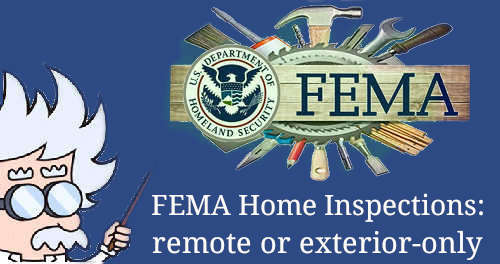By Murray Wennerlund published 11-16-2024 updated 11-16-2024
|
|
|

By Murray Wennerlund published 11-14-2022 updated 11-15-2022

By Murray Wennerlund published 11-14-2022 updated 11-15-2022
Most states are treating disasters from 2020 to 2023 as typical disasters by requesting a FEMA damage inspection. Your states emergency preparedness people may not have read their own internal federal memorandums about COVID-19 Policy and inside home inspections.
Release Date: Oct 15, 2021 Republished by FEMA 11-14-2022:
FEMA Home Inspections: What to Expect
There are two ways your home may be inspected:
1. Remote inspection: FEMA calls you and schedules a phone/remote/virtual inspection. This inspection is done entirely over the phone. Most often, the survivor answers questions that will help detail the extent of their damage.
2. In-person, exterior-only inspection: FEMA calls you to schedule a time for an inspector to visit your home. Taking COVID-19 protocols into consideration, the inspector will not enter the building, just the property, and will inspect from outside.
The inspector who arrives for the appointment will have an official FEMA badge. If you don’t see an I.D. badge, ask to see their FEMA identification before proceeding. The inspector will ask you for a photo ID to confirm you are the applicant.
End Snip from FEMA home inspections document.
Full PDF of FEMA Home Inspections: What to Expect can be viewed here.
For Disasters inspected in 2020 you were not offered any method of internal inspections. You would have had to document and photograph all the damage caused by the declared disaster yourself. If you have not made repairs you can still document and submit your damages.
FEMA's document states: "If you applied with FEMA and you cannot live in your home because of damage caused by Hurricane Ida, a FEMA inspector will contact you to set up either a remote or in-person, exterior-only home inspection."
Then goes on to say: "FEMA home inspections help determine whether a home is safe, sanitary and livable. To determine whether an applicant is eligible for assistance, FEMA considers the home’s interior and exterior structural soundness whether the electrical, gas, heat, plumbing and sewer or septic systems are functional and whether the home is livable and can be entered and exited safely."
Over the phone or via Video Call FEMA is not going to be able to determine if your home inside is safe to live in. This is going to take the effort of someone that has your best interest in mind and wants to make sure nothing is missed by a voice or video call and photographs of the damage detailed in a written report. So what does FEMA do to help those that aren't actually able to inspect and document their own homes? They allow you to appoint a friend to do the report.
FEMA's "What to expect" document states: "Survivors who are unable to meet with the FEMA inspector for an in-person inspection or are unable to complete a remote inspection themselves with an inspector, can have a friend or relative act on their behalf to meet with the inspector. But first they must submit to FEMA a written and signed request for third-party, which is a legal document, authorizing another person who is at least 18 years of age to meet with the inspector and to provide and receive information from FEMA on their behalf."
Because we are still seeing FEMA inspectors not willing to actually enter homes this allows a third-party (friend) to do the inspection and document everything damaged due to the disaster and upload it to your FEMA account.
The inspection process, remote or in-person, usually takes 30 to 40 minutes. If you were able to take photos or video of interior or exterior damage to the home, show them to the inspector.
Call FEMA 800-621-3362 to schedule your inspection after you read the following points.
If you need help with your appeal don't wait days or weeks to get started. This may require the assistance from others including myself.
I will be providing basic wording for appeals and how to document the damage with your camera or smart device.
Louisiana Hurricane Ida damage reports have been pulled by the state office of community development and they used that information to determine your eligibility before you even applied. This is the first time in decades that the sate is not allowing you to provide a private inspection report or contractors estimate of damages to be accepted into the program. It appears this method of operation will disqualify 10's of thousands before the program opens the checkbook. It also explains why they are only allocating $300,000,000 for homeowners and renters. Not very much, might assist 7,000 to 8,000 homeowners in total.
Resource Research: